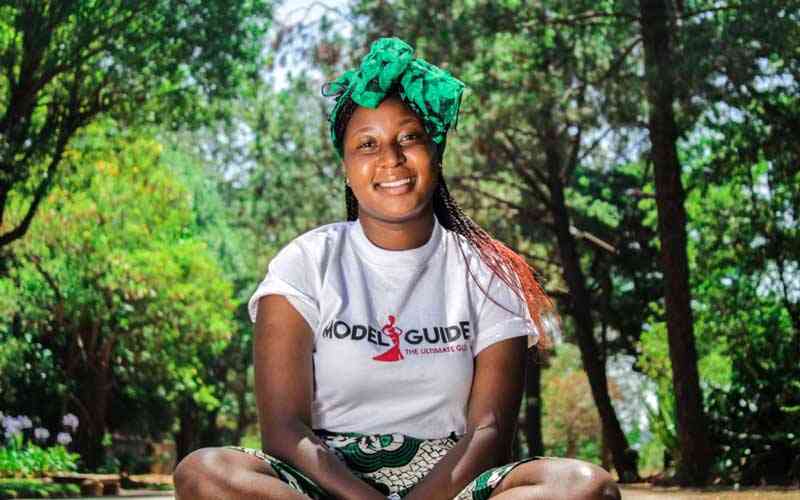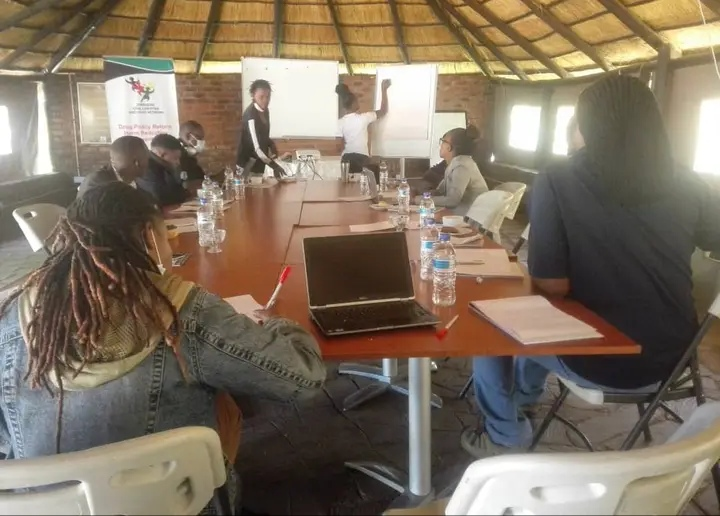
Defining a model in artistic and creative language evokes imagery and symbolism that transcends mere physical appearance.
Nowadays every person who owns a smart phone can take a picture and in the process pose as a model.
Being picturesque is what drives us, but I am of the belief that there is a deeper aesthetic value in defining oneself as a model as it requires grooming and discipline.
I see a model as a living canvas and a sculpted vessel of expression.
The form of beauty becomes the brush stroke that resembles the tapestry of life, and models are the embodiment of the real beauty and muse for creation that resembles the symphony of lines and curves dancing with harmony.
The description of beauty is usually poetic as it is admiration, as the essence of beauty is something that also has to come with brains.
Lewis Nyamakosi is one such modeling enthusiast who got the inspiration to venture into modeling as he wanted to help a friend that wanted to start a career in modeling.
Nyamakosi tells Standard Style how during the days he ventured into modelling there were a few modeling agencies and he could not find the perfect modeling agency for his friend.
- Ex-Q, Winky D, Baba Harare head for Odyssey
- Music teacher celebrates African heritage
- Ex-Q, Winky D, Baba Harare head for Odyssey
- Byo singer elated at playing on African music charts
Keep Reading
It was after a long time of searching that he decided to research about modeling from the internet and watched modeling videos on YouTube that he trained his friend. From then, he decided to form his own modelling agency which he calls Model Guide Zimbabwe.
“Many people think that modeling is all about dressing in fancy attire and travelling to different places, and all the glitz and glamour, but this is not what modeling entails.
"Through modeling, individuals often become more comfortable and confident in their physical appearance. They learn to appreciate their unique features and characteristics, as well as how to present themselves effectively to others.
"This can lead to increased self-esteem and body positivity,” Nyamakosi said.
Modeling involves a range of skills such as posing, walking, facial expressions and interacting with photographers and clients.
Models need extensive grooming to gain experience and proficiency in these areas, and they develop a sense of competence and mastery that inherently contributes to their confidence.
Nyamakosi also explained that models often receive positive feedback from clients, photographers, designers, and others in the industry when their work is well-received.
This feedback reinforced their skills and abilities, boosts their self-esteem, and validates their efforts, leading to increased confidence in their talents.
Nyamakosi also gave light on the link between modeling and development which is another interesting facet of note.
"Modeling reflects and contributes to cultural development by showcasing diverse perspectives, aesthetics, and identities. Through fashion, photography, and other forms of visual expression, models and artists can challenge stereotypes, celebrate cultural heritage, and promote inclusivity and diversity.
"Modeling as an art form can serve as a platform for cultural exchange, dialogue, and understanding, fostering appreciation for different cultures and traditions. This is the approach that can enhance the growth of the Zimbabwean modeling industry," he said.
An issue of note is with regard to how modeling can be demanding and challenging, requiring models to step out of their comfort zones, adapt to new situations, and handle rejection or criticism.
Successfully navigating these challenges and overcoming obstacles can build resilience and confidence in one's ability to cope with adversity.
“In addition to modeling on the runway or in photo shoots, models may also engage in public appearances, interviews, and promotional events where they interact with the public and media. These experiences can enhance their public speaking and presentation skills, leading to greater confidence in social situations," Nyamakosi explained.
As a tool of edutainment, modeling can play a role in social development by promoting social interaction, collaboration, and community engagement.
Models often work closely with photographers, designers, stylists, and other industry professionals, fostering teamwork, communication skills, and interpersonal relationships.
Additionally, modeling can provide opportunities for models to engage with audiences, advocate for social causes, and inspire positive change within their communities.
Modeling encourages individuals to project confidence, poise, and charisma, even when they may not feel it internally.
Over time, this practice of "acting confident" can influence their self-perception and contribute to the development of a more positive self-image.
One of the hardest questions I asked Nyamakosi was with regard to how he protected female models in particular from abuse as they remain vulnerable to its scourge.
In his response he outlined that before they agree to work with a client, they would do a background check and see how they had previously worked with other models.
Adding to this, his agency also ensures that they sign a contract with their models and clients and also abide to the contract which guides the mode of behaviour between the agency and the model during and after the project.
He also explained that he always has a team to accompany his models to the shoots or pageant so as to reduce the incidences of the models falling victim to any forms of abuse.
It remains important for agencies, clients, and industry organisations to establish clear guidelines and codes of conduct that prohibit sexual harassment, exploitation, and abuse of models.
These guidelines should outline expectations for appropriate behavior and consequences for violations.
Nyamakosi also explained that at his agency, models receive education and training on their rights, boundaries, and how to recognise and respond to instances of sexual exploitation or harassment.
These training programs empower models to assert their boundaries, communicate effectively, and seek support when needed.
With regard to the challenges in running a model agency, he outlined that:
“Modeling is a competitive and evolving industry, and successful models continuously seek opportunities for learning, growth, and skills development. This may involve attending workshops, classes, or seminars, as well as staying informed about industry trends and advancements. It requires dedication, hard work, professionalism, and the ability to adapt to the demands of the industry while maintaining a positive attitude and strong work ethic.”
Modeling as an art form can contribute to personal, social, cultural, creative, and professional development by fostering self-expression, celebrating diversity, promoting social interaction, encouraging creativity, and providing opportunities for career growth.
Through modeling, individuals can explore their identities, connect with others, and make meaningful contributions to the world around them, contributing to their holistic development and well-being.
- Raymond Millagre Langa is a musician, poet, orator, independent researcher and founder of Indebo edutainment Trust. You can follow him on Facebook @Millagre Ray Langa, on X you can follow on #Millagre Langa, email. millagrepapito@gmail.com or indebotrust@gmail.com










